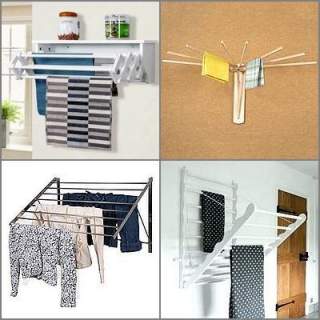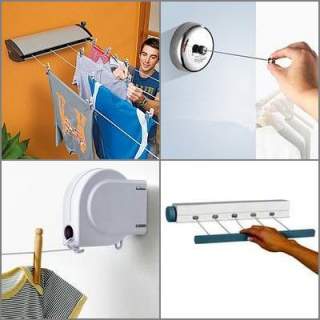How to Air Dry Clothes Indoors
Drying laundry indoors has different challenges than drying outdoors. This article will provide the information you need to successfully air dry your clothes indoors. Let's get started...
Guide to Indoor Laundry Drying

Will laundry dry better indoors or outdoors?
The conditions for optimal air drying of clothes are:
- Low humidity
- Warm temperature
- Moving air (ventilation)
Sometimes the outdoors has a good combination of these conditions (a warm, dry, breezy day), and other times the conditions outside are poor (a muggy, cool, still day). If you can only do laundry on the weekends, and it rains all weekend, then you won't be able to dry outdoors.
But indoor conditions are usually more consistent, and often adjustable. For drying clothes indoors, it helps to analyze each room in the house, and consider easy tricks to enhance the drying conditions.
- Bedrooms
- Normally warm and dry. Open door and run a small fan for air movement.
- Space is available in these rooms during the work day.
- Drying only that occupant's clothes in their room allows easy putting away.
- Living Room / Dining Room
- Normally warm and dry, and open for some air movement.
- Problems can include traffic and crowded space.
- Overnight drying with a ceiling fan running is an option.
- Kitchen
- Not common, but a small wall rack for towels and washcloths possible.
- Bathroom
- Can be too humid right after a shower or bath. Keep the door open.
- When hand washing clothes, drying in the tub allows soggy items to safely drip.
- Basement
- Problem if the basement is damp, cool, or poorly ventilated.
- But those that are also living spaces are OK, and often have ample space.
- Garage
- During warm seasons, the garage can work very well.
- Leave the garage door open, at least part way, for ventilation. Fans always help.
- Plenty of space, and possibility for clotheslines attached to the walls.
How long will it take to air dry clothes?
The honest answer is "It depends". So many factors come into play, that the items from the same load of laundry will become dry at different times. How long it takes to air dry clothes depends on:
- Wringing/Spinning: Items that start out soggy will take much longer to dry.
- Fabric type: synthetics dry faster than natural fabrics.
- Thickness: A thick cotton towel will take longer that a thin cotton tee shirt.
- Folds/Layers: Layers (pant legs, folded towels) take longer due to less air movement.
- Room's drying conditions: (see above)
For a load of laundry that was spun in a washing machine, and hung indoors in average conditions, the "easy" items will be dry in about 5 hours, and the "difficult" items will finish in about 9 hours. Also see our Air Dry All Types of Clothing article for tips on each different clothing type.
What type of indoor drying rack is best?
The types of indoor drying racks and clotheslines include:
- Floor-standing Racks
- Wall-mounted Racks
- Retractable Clotheslines
- Ceiling-mounted Racks
Floor-standing Racks:
- Pros:
- portable – can be moved to the room with best conditions
- compact – fit into small unused spaces
- affordable – multiple units can be used to best use available spaces
- foldable – easy to close and store
- Cons:
- tippy– can be knocked over accidentally, or by a breeze if put outdoors
- fragile – the cheap units are often weak, and not repairable
- layering – having one rod above another can lead to layered fabric that drys slowly

Wall-mounted Racks:
- Pros:
- convenient – uses space that is plentiful and readily available
- affordable – multiple units can be used, and are often needed with this type
- foldable – easy to close and get out of the way
- Cons:
- permanent – requires being firmly fastened to the wall
- overload danger – large heavy loads, or misuse, can pull it from the wall
- appearance – finding a design that matches your décor may be difficult

Retractable Clotheslines:
- Pros:
- convenient – uses overhead space available at different times of day
- affordable – multiple single-line units can be used to best use available spaces
- storage – easy to close and store and large amount of rope space
- Cons:
- permanent – requires being firmly fastened to the wall
- overload danger – large heavy loads, or misuse, can pull it from the wall
- line looseness – cheaper brands are prone to rope sagging and looseness
- appearance – housings for large parallel line models often not attractive

Ceiling-mounted Racks:
- Pros:
- convenient – uses un-used overhead space
- efficient – drying on these racks avoids layering and captures warmer conditions
- storage – stores overhead and out of the way
- Cons:
- permanent – requires being firmly fastened to the ceiling
- overload danger – large heavy loads, or misuse, can pull it from the ceiling
- appearance – finding a design that matches your décor may be difficult
- complexity – managing the cords used to lift the unit is difficult for some

